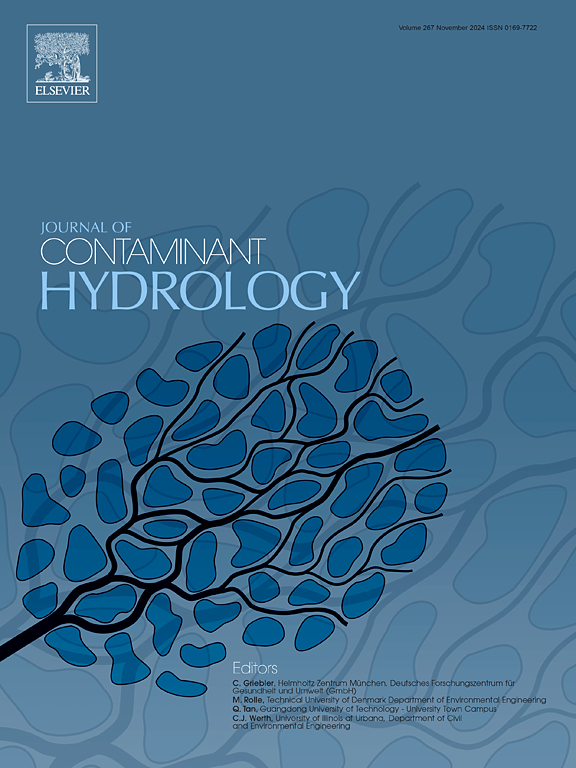Spatiotemporal distribution and ecological hazards of microplastic pollution in soil water resources around a wastewater treatment plant and municipal solid waste site
IF 3.5
3区 环境科学与生态学
Q2 ENVIRONMENTAL SCIENCES
引用次数: 0
Abstract
Research into the relative contributions of microplastic (MP) sources to aquatic and terrestrial environments is essential for understanding their fate and transport which is a prerequisite for designing effective pollution management strategies. This study explores the spatial distribution, seasonal variations, and ecological hazards of MPs in surface water, groundwater, soil, sediment, and leachate matrices adjacent to municipal solid waste (MSW) and sewage treatment plant (STP) sites in Northern India. Elevated MP concentrations were observed in leachate (283.22 ± 15.78 particles/L; pre-monsoon), whereas groundwater exhibited significantly reduced levels (10.75 ± 2.04 particles/L; pre-monsoon), indicating the attenuation efficiency and filtration potential of the subsurface zone. Seasonal variations revealed a dilution effect from monsoonal runoff, reducing MP concentrations. The identified MP shapes were predominantly fibers, followed by fragments, with transparent particles being the most common. The size distribution was dominated by smaller MPs (<0.3 mm), which exhibited a positive correlation with overall MP concentrations. The polymer types of MPs identified in the samples categorise the polymer hazard index (PHI) as a hazard level V (>1000) in all the samples indicating a high chemical risk in both the seasons. Similarly, the principal component analysis (PCA) revealed MP hotspots, particularly in soils near the MSW site, with concentrations reaching 53,580 ± 720 particles/kg emphasizing the vulnerability of terrestrial systems. This research highlights the importance of implementing effective waste management practices and provides valuable insights into the fate and transport of MPs by presenting strong evidence of MP movement from typical MSW/STP sites into adjacent land and water resources.

某污水处理厂及城市生活垃圾填埋场周边土壤水资源微塑料污染时空分布及生态危害
研究微塑料(MP)源对水生和陆地环境的相对贡献对于了解其命运和运输至关重要,这是设计有效污染管理策略的先决条件。本研究探讨了印度北部城市固体废物(MSW)和污水处理厂(STP)附近地表水、地下水、土壤、沉积物和渗滤液基质中MPs的空间分布、季节变化和生态危害。渗滤液中MP浓度升高(283.22±15.78粒/L);季风前),而地下水水平显著降低(10.75±2.04颗粒/L;季风前),表明地下带的衰减效率和过滤潜力。季节变化揭示了季风径流的稀释效应,降低了MP浓度。确定的MP形状主要是纤维,其次是碎片,透明颗粒是最常见的。粒径分布以较小的MPs (<0.3 mm)为主,与总MPs浓度呈正相关。样品中确定的MPs的聚合物类型将所有样品中的聚合物危害指数(PHI)归类为危害等级V (>1000),表明两个季节的化学风险都很高。同样,主成分分析(PCA)也揭示了MP热点,特别是在城市垃圾填埋场附近的土壤中,浓度达到53,580±720颗粒/kg,强调了陆地系统的脆弱性。本研究强调了实施有效的废物管理实践的重要性,并通过提供有力的证据,为MPs的命运和运输提供了有价值的见解,这些MPs从典型的MSW/STP站点移动到邻近的土地和水资源。
本文章由计算机程序翻译,如有差异,请以英文原文为准。
求助全文
约1分钟内获得全文
求助全文
来源期刊

Journal of contaminant hydrology
环境科学-地球科学综合
CiteScore
6.80
自引率
2.80%
发文量
129
审稿时长
68 days
期刊介绍:
The Journal of Contaminant Hydrology is an international journal publishing scientific articles pertaining to the contamination of subsurface water resources. Emphasis is placed on investigations of the physical, chemical, and biological processes influencing the behavior and fate of organic and inorganic contaminants in the unsaturated (vadose) and saturated (groundwater) zones, as well as at groundwater-surface water interfaces. The ecological impacts of contaminants transported both from and to aquifers are of interest. Articles on contamination of surface water only, without a link to groundwater, are out of the scope. Broad latitude is allowed in identifying contaminants of interest, and include legacy and emerging pollutants, nutrients, nanoparticles, pathogenic microorganisms (e.g., bacteria, viruses, protozoa), microplastics, and various constituents associated with energy production (e.g., methane, carbon dioxide, hydrogen sulfide).
The journal''s scope embraces a wide range of topics including: experimental investigations of contaminant sorption, diffusion, transformation, volatilization and transport in the surface and subsurface; characterization of soil and aquifer properties only as they influence contaminant behavior; development and testing of mathematical models of contaminant behaviour; innovative techniques for restoration of contaminated sites; development of new tools or techniques for monitoring the extent of soil and groundwater contamination; transformation of contaminants in the hyporheic zone; effects of contaminants traversing the hyporheic zone on surface water and groundwater ecosystems; subsurface carbon sequestration and/or turnover; and migration of fluids associated with energy production into groundwater.
 求助内容:
求助内容: 应助结果提醒方式:
应助结果提醒方式:


